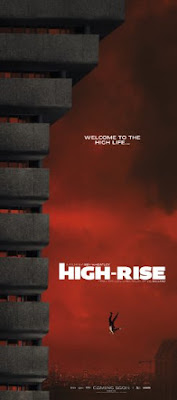"High Rise"

Title: High Rise
Director: Ben Wheatley
Writer: Amy Jump (screenplay), J.G. Ballard (novel)
Category: Action, Drama, Sci-fi
Duration: 112 min
Rate: 



Set in 1975, High Rise takes place in a modern skyscraper newly built. Each floor is a micro representation of the social structure in the 70's, which is still easily applicable to our modern society. At the penthouse and the highest floors there are the luxury apartments for the upper-class. They are portrayed as greedy, egotistical and self-centered. On the middle floors there is the middle class and at the first floors the lower class.
The skyscraper is completely self-sufficient, every commodity is available to its residents, so much so that they end up isolating themselves from the rest of the world without leaving the building.
At first everything seems to go smoothly. The residence is fascinating and each resident has its own space, interacting only with the others from the same social class and the floor. There is an atmosphere of everlasting celebration and no one seems to care about squandering money or food according to their own economic means. The only person who doesn't fit in any of the social divisions is Robert Lang, a psychologist who moved inside the building because he is looking for a change. In the mist of everything he is there to observe without being completely involved in what is happening around him. He is passively witnessing all the overindulgences that all the other residents seem to relish without integrating himself. He is there to act as an external observer in a social experiment in order to take note of every result.
However, what seems to be the perfect prototype of luxury and functionality, slowly starts to show structural failures. The overpopulation in the building is causing disruption in the energy distribution and each apartment starts to malfunction. The situation could be easily resolved by leaving the skyscraper, however, all the residents alienated themselves too much from the rest of the world to even realise that there is something else outside. Instead of leaving the building, all the different social classes start to form coalitions in the desperate quest to conquer the higher floors of the building. The fights quickly escalate into social wars to "dethrone" the upper-class.
To the people who didn't read Ballard's book, the first impact with High Rise can remind of a drug induced trip.
The movie is set entirely in this newly built skyscraper. The interior designs are made according to the 70's style and each apartment reflects the people who live in it, from the upper class' extra luxury apartments to the more modest ones for the middle class. Even in the scenography , the audience is reminded that Robert Lang doesn't belong in any social class: His apartment is bare and there aren't any personal effects scattered around. Each room has different labeled boxes to show his precariousness in the building as well as in the social scale.
The dialogues in High Rise are fragmented in a way that reminds of the theatre of the absurd. The interactions among the characters are brief and seemingly incoherent.
Ben Wheatley's direction is dynamic in following every actor' movement and the scenes are assembled in a sharp way in order to follow the plot's chaotic flow as if to reaffirm the anarchy in the story. The cinematography moves from close ups to panoramic shots and the slow motion technique is often used brilliantly, especially in capturing the most eccentric scenes in the film. By slowing down and framing every detail it looks like the director wants to seize all the moments in which each character starts to lose any inhibition letting all the primordial instinct take over.
Along with the cinematography, the cast brought brilliantly to life Ballard's characters. Tom Hiddleston naturally shows Robert Lang's stoicism and attention to every detail. The only scenes in which his character is involved with the others are the ones he shares with Sienna Miller and Elisabeth Moss. His relationship with them are purely physical and always motivated by irrationality.
In its entirety, the cast ensemble brought great performances to the screen. Particularly worth mentioning is Luke Evans' interpretation of his character Richard Wilder, a man desperately looking for success and fame who is ready to kill for it. In his performance the audience can see the representation of that insane thirst for fame that, especially nowadays, seems to be what everyone is yearning for.
All in all, High Rise is a film that, underneath the glossy and psychedelic chaos typical of the 70's, is masking a strong criticism against consumerism and social hierarchies. However, it is still capable of showing how in 1975 Ballard predicted how this ec onomic and social phenomena, along with technology, would completely change any social relations hip and the way in which everyone would live their lives.
Till next time,
Fred.
Here's the trailer:


Comments
Post a Comment